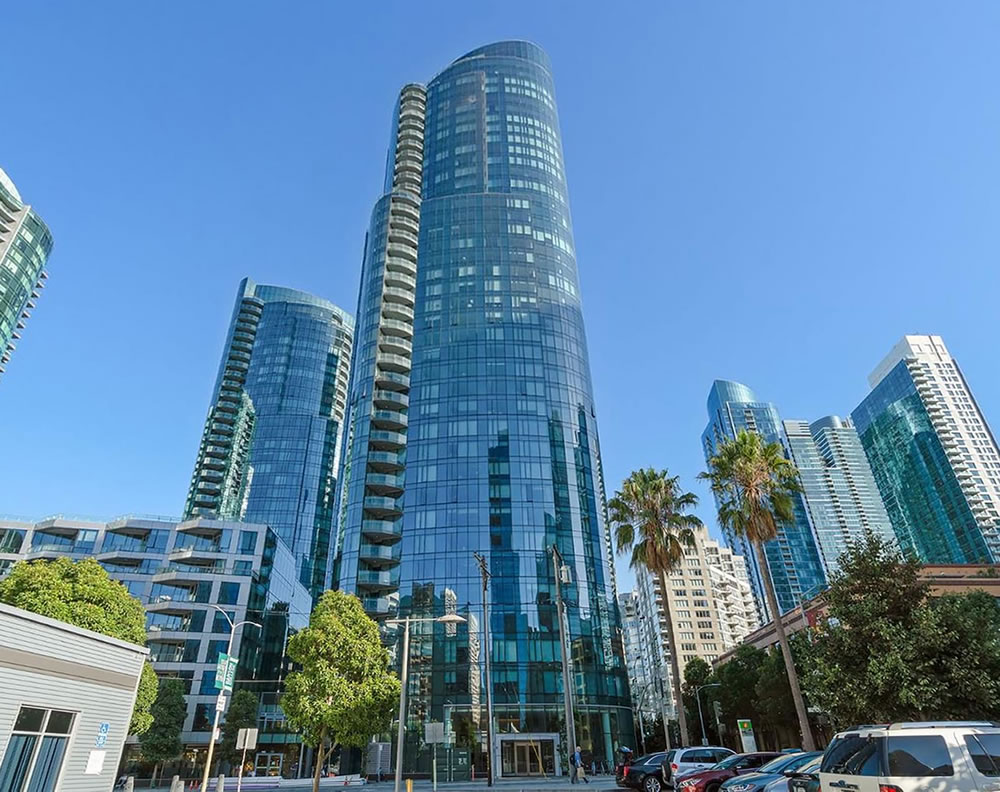Purchased for $1.65 million in November of 2017, the high-floor unit #35D in the Lumina tower at 201 Folsom Street, a “stunning 1-bed, 1-bath + den gem with amazing views of the Bay from every room,” returned to the market priced at $1.728 million in January of 2020.
Relisted anew for $1.578 million in November of 2020, the asking price for the 972-square-foot unit was reduced to $1.478 million after another month on the market and the unit was then withdrawn from the MLS.
Returned to the market listed for “$1.218 million” this past September, 201 Folsom Street #35D was then re-listed for $1.318 million in October when an acceptable “over asking!” offer and bidding war failed to materialize.
Relisted anew for $1.35 million last month, the resale of 201 Folsom Street #35D has now closed escrow with a contract price of $1.175 million, which “isn’t exactly cheap!” at $1,209 per square foot, as some like to say in an effort to downplay the market weakness and drop, but is 27.7 percent cheaper than six years ago on an apples-to-apples basis, net of any temporal gains between and despite the fact that the frequently misreported index for “San Francisco” condo values is “still up over 10 percent!” over the same period of time.
And for those running the numbers at home, beyond the basic deprecation, the monthly HOA dues for the have been running around $1,300 per month and the day after the resale closed escrow the one-bedroom was immediately listed for rent at $5,490 per month.






Looking at the tax records, it appears it was owned by an investor who got their fingers burned.
Can someone help me understand the economics as a real estate outsider?
$1.175M purchase price
$5,490 rent
$1,300 HOA dues
$1,157 monthly property tax
So a 3.1% return? Are my numbers right?
Why would an investor buy this for a 3.1% return when they can get 5% interest in a money market account?
Maybe it’s a 1031 exchange and they’d rather buy in a falling market rather than pay the taxes?
Any other insights?
Regarding your opinion that it is a “falling market”, opinions could vary regarding how long it will continue to fall.
If interest rates decline, expect real estate to get more expensive. Even in San Francisco. Buying when interest rates are high can be a good strategy if you expect to refinance later at a lower rate. Those juicy MM account rates probably won’t stay high forever (inflation is moderating).
“[…] opinions could vary regarding how long it will continue to fall.”
I can think of a particular cohort that believes prices only ever go up and that one must buy now or be priced out forever. It’s unsettling, though, to ponder that the viability of such a massive, illiquid asset class is based so heavily on low. low interest rates that historically obtain only during economic crises. Maybe shelter should be shelter, and not fodder for Ponzi schemes and other speculative manias?
I’m certainly no expert on whether the market will continue to fall or not.
But it seems that in the long run, the market should be priced at a point that would give an investor a rational reason to buy a unit and rent it out.
And if this unit is an example, we seem to be far away from that equilibrium.
This seems almost an apt place to bring up John Maynard Keynes’ famous quote about how long the market can stay irrational. But not quite.
As far as whether or not this unit is indicative of the market overall, you can compare this to a fully furnished unit a floor lower, same floor area, same number of bedrooms (and “a Murphy bed in the den” area) and baths that is on the rental market for about 3.7 percent more than Apt 35D. And those are not the only two units in this situation at 201 Folsom St. so this new lessor can’t just make up a rental rate that is an attractive amount over and above the risk free rate of return and be assured of getting someone to bite.
In order for that apartment to be affordable, a potential tenant would have to have an income of at least $228,000 per year.
Layoffs, layoffs everywhere, including those in the 200k+ income sphere. Turns out, this cohort is front of line leading out to the plank. So among those still pulling a large salary – I wonder about the appetite for lavish spending. Or rather get a 2br on the West Side or somesuch for half the rent and sock away the difference for another day?
What’s going to support home, townhouse and condominium values in the major metropolitan area with the highest commercial office vacancy rate in the USA? Massive tech, biotechnology and other industries are shedding employees in numbers few people had the sense to imagine until now.
While the response to high office vacancy rate in downtown SF is to encourage conversion of office space use to residential use, thereby dumping more residential units on the market and driving down the value of residential units even further. SF city hall appears gridlocked by politics and unable to improve quality of life street issues, so they will remain frozen in their position like a deer in the road staring into the headlights of the oncoming vehicle.
The City is and has been “encourag[-ing] conversion of office space use to residential use”, but as you’d know if you have been following this site for any time during the last year or so (scroll down to ‘graph six):
While I think this is a tiny bit of a misrepresentation of the case for conversion (very few knowledgeable people are advocating converting “all the vacant office space”, most are advocating the conversion of older, smaller floor plate buildings), it does address the probability that the market will be meaningfully moved by newly-converted units. Since the cost of conversion and bringing the new units to market won’t be covered by the sales prices of those new units, there’s no compelling business case for office space conversions.
Even in the older building, smaller floor plate scenario, there isn’t going to be a wholesale “dumping [of] more residential units on the market and driving down the value of residential units even further.” Barring some truly unprecedented public policy interventions like NYC-style property tax abatement or outright developer subsidies from The State, the impact of office space to residential conversions, assuming that they happen at all, will be so tiny as to be considered noise in the market data.
It’s almost as if putting all of a city’s economic eggs in one basket by repurposing almost all land used for production, distribution, and repair into boom and bust cubicles and condos for digital doodlers wasn’t a very smart idea after all, and only served to make a small number of speculators very rich, while gutting the exact type of jobs that cannot be worked remotely. Who coulda knowed?!
“San Francisco’s biggest office landlord isn’t expecting leasing to improve much this year amid tech’s continued layoffs and cost-cutting.” SF chron.
” only served to make a small number of speculators very rich”
What is your evidence in support of this claim?
“Why would an investor buy this for a 3.1% return when they can get 5% interest in a money market account?
Maybe they’re not a smart investor? Or maybe they’re not an “investor” at all? Not all inorganic demand is for “investing” purposes. Irrational speculating, money laundering, tax dodging, trust-fund dilettante-ing, foreign capital fleeing, pied a terre-ing, perhaps, among others? The set of inorganic demand is large, and contains multitudes. It is astonishing how big a hit this property took, and it’s also astonishing that anyone bought it at this still-elevated price..
Interesting to consider a dumb or irrational person.
But can the market really have so many dumb or irrational people in it to make the going rates so out of whack with reality?
I feel like I must be missing something.
Oh. A few things…
1. That 3.1% is tax advantaged since you get to deduct depreciation. Also only 80% of rental profits are taxable.
2. Since this is a condo it isnt subject to SF rent board caps on rent increases so your rental income will grow with the market.
3. Your underlying I purchase will appreciate over the very long term. On the short term your mileage may vary….
There’s also the $7,500 security deposit the investor gets from the tenant to hold for the duration of the lease, which is in this case is at least 12 Months.
If you want to get into the weeds, then you also have to consider the $13k in transfer tax and the 10s of thousands of dollars in real estate commissions.
Don’t forget to pay the 5.2% interest due on that security deposit (name link). “Interest payments apply to all residential rental units in San Francisco, including those exempt from the Rent Ordinance…”
Thanks, Mark and tipster. Both are relevant points I overlooked.
looks like nobody has mentioned the other costs for an owner which includes insurance, special assessments, vacancy of the rental (rental units are not getting scooped up quickly these days and may require some incentives to out-compete other landlords).
Rents are not static. To accurately forecast this investment over a 5-year investment horizon, you would want to project what rents will be in 2029. I remember renting a 3 bedroom in the mission for $3k in 2009. Rents are likely to grow at least as fast as inflation.
HOAs tend to be pretty stable, growing with inflation. Prop 13 limits property taxes growth to 2%.
If rents grow at 5%, HOAs at 3%, and taxes at 2%, by 2029 this investment will be earning a 4.0% unlevered free cash flow yield.
The 5.1% rate is a false herring. That’s a 6-month rate, not a 5-year investment. Your real alternative is buying the 5-year Treasury bond which today yields 4.0%. This bond is not inflation protected – in 2029 you will receive exactly $1000 back. Land values appreciate with inflation over the long term (not guaranteed though, as this very example highlights). But the investor today is probably expecting their investment to gain value along with rental income growth. So the real alternative is a 5-year TIPS bond, yielding just 1.8% today (but your principal is guaranteed to grow with CPI). Hopefully by now you can see that the condo investment is has a much higher return potential than your example of a risk-free investment in government debt.
Then you factor in two considerations unique to real estate: 1) ability to defer income taxes through 27.5 years MARS depreciation (and then defer them forever through a 1031 exchange) and 2) ability to lever investments 4:1 with 30-year fixed rate mortgages. I will leave this calculation to the reader.
> If rents grow at 5%, HOAs at 3%, and taxes at 2%
Your calculations are more thorough than the simple comparison to the money market rate, but on the other hand it seems like most of your numbers are just taking points from the past decade or two and drawing lines through them indefinitely into the future.
Assuming that rents will grow more than HOAs forever seems equivalent to positing that housing will remain in a state of increasing scarcity indefinitely. Eternal NIMBYism? And HOA fees are still subject to market forces that can themselves be capricious, such as the wages of plumbers, HVAC, elevator techs, and accountants.
“Land values” is an interesting one since land values are of course entirely a political construct—namely, they represent the difference between the fair market land rent for a parcel and the property tax levied by the state. Prop 13 nominally provides assurances in this regard, but they seem less than comforting as essentially the last vestige of Reaganism in a state that has been sprinting leftwards for decades.
You haven’t captured annual depreciation nor an exit value in your analysis (oh and btw, until 15 months ago money markets were at 1%). I had similar economics on the annual return when I bought a rental nearby in 2008 and sold in 2016, but exited with $800,000 in appreciation (though a chunk lost to capital gains). The exiit pumps up your overall yield/return considerably if it is timed right.even accounting for time value of money. Though it’s an incredibly (financially) dangerous game to play to try time the market. But SF does have boom and bust cycles.
$1 million/ bedroom (+$468,000 in HOA over course of 30 year loan) is insane.
Two Beers once again has earned a 3rd.
Curious as to condo owners or investors would agree that HOA fees hold steady at 3% increases? A thousand sq ft loft in the mission is up to $750/m and has no common spaces other than unattended minimal entry and hallways. Covers building insurance, water and trash. 32% growth over 5 yrs and HOA is woefully underfunded in reserves for capital projects (roof, carpets, paint, new water heaters). Just optics of insurance and energy prices escalating tell me this is a variable that even long term rents are not keeping up never mind current state with rents going down in the face of these increases.
Condo assessments are rising at much more than 3% per year. Insurance premiums are a significant factor (rate increases for liability/fire insurance have increased by orders of magnitude in the last two to three years) but IMO the prime factor is the way most condo buildings are underassessed by the developer at inception. Developers know that assessments are an impediment to purchase and therefore strive to keep them low. This means that most capital repairs, maintenance, and useful life replacements are underfunded from the start, and the gap only continues to grow with time. The Davis Stirling Act allows a Condo Board to raise monthly assessments by twenty percent (20%) annually without a member vote, but even minor increases result in significant pushback from members, including recall petitions and lots of sharp conversations in the common area spaces. It’s very difficult (and expensive) to “catch up” to the correct monetary reserve level when there are so many factors working to keep assessments low.
You probably did not mean “orders of magnitude” because that means that insurance has risen at least 100X higher compared to three years ago.
I think you’re being a little pedantic; colloquially it’s used to mean more than a fractional increase…so doubling or tripling. I don’t know if insurance actually increased that much, but if it did I think we should move on.
The words “doubled” or “tripled” would be better. No need to exaggerate.
$1.175 million must be one of the lowest prices for something on the 35th floor or higher.
So you can gaze out and look at a city with a $1.4B budget deficit and pretend they won’t come for people buying $1M+ condos to close that gap, which is getting worse with every condo or office property sale.
I just saw a comment made by a prominent San Francisco realtor who does tons of these SOMA condo deals (used to?). He said something like “the pivot is here!” referring to some miniscule uptick in sales volume. If this is the pivot he’s referring to, I say get out now before another tech layoff and million square feet of office space hits the market. San Diego is looking pretty good right now.